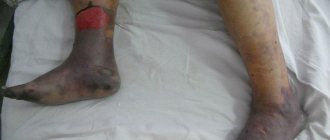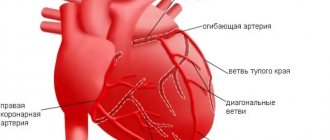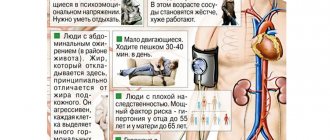Atherosclerotic plaques are the direct cause of the development of such an insidious and dangerous disease as atherosclerosis. The pathology is characterized by changes in the condition of the vessels, which become fragile, lose elasticity, their lumen narrows, and neighboring organs do not receive enough oxygen and nutrients.
The formation of plaques can begin at a fairly young age, but pronounced signs of atherosclerosis appear more often after a person reaches 50 years of age. Today we will talk about why deposits form on the walls of blood vessels, what they are, and methods for timely diagnosis and treatment.
What it is
First, it is necessary to explain what atherosclerotic plaques are. The development of atherosclerosis begins with cholesterol deposits on the walls of the arteries, aorta, large and small capillaries, which can be located in any part of the body.
To ensure that all internal organs and the brain are fully supplied with blood, the inside of the vessels is lined with a special layer - the endothelium. With excessive accumulation of lipid substances inside the capillary, its lumen becomes narrower, the endothelium suffers from the introduction of “bad” cholesterol. The walls of the arteries become rougher and tougher.
As the disease progresses, the calcified growths increase in volume and harden, taking on the shape of tubercles, which is why the lumen of the artery may be completely blocked. Plaque formation typically occurs in all areas of the body, and the resulting bumps contain calcium and foreign substances.
Composition and types of plaques
If a person’s blood vessels are soft, elastic, and their tone is normal, then special substances prevent the formation of atherosclerotic plaques. These are wall enzymes designed to dissolve fats that accumulate inside the capillaries. The beginning of the process of formation of pathological tubercles on the walls of arteries involves a combination of negative conditions.
This may be due to poor nutrition with excess animal fats in the diet, damage to the walls of capillaries, which lose their elasticity and become loose. The formation of plaques in blood vessels takes more than one year - first there is an active deposition of cholesterol, only then it becomes overgrown with connective tissue fibers and turns into a pronounced hard tubercle.
A plaque is essentially a core surrounded by a shell consisting of cholesterol and esters. And the environment is a mixture of fats and macrophages, and the fats gradually destroy the macrophages and enter directly into the nucleus. The part of the plaque that protrudes into the lumen of the vessel is a fibrous membrane; it consists of elastin and collagen. The content of these substances determines whether the plaque will rupture or remain intact.
At the stage when the plaque has just begun to form, its structure is semi-liquid, so a particle of the growth can come off, move along the inside of the capillary and completely clog it. At this time, the formations can still resolve with adequate treatment, which is why experts advise paying attention to the primary symptoms of atherosclerosis rather than waiting for dangerous complications.
As the disease progresses, the growth becomes overgrown with calcium, acquiring an increasingly dense structure. A slowly growing calcified plaque does not allow blood to fully flow to the internal organs and the brain (depending on the location), which causes a deficiency of oxygen and nutrients in the tissues.
If we explain the mechanism of formation of plaques in blood vessels, then the process consists of certain stages:
- Deposition of lipids on the vascular wall.
- Connection to the process of leukocytes, which contribute to the development of an active inflammatory process.
- Penetration of monocytes into the vascular wall with the further release of macrophages with a porous structure.
- The beginning of pathological changes in the state of the internal arterial layer.
- Adhesion of platelets to that part of the wall where the process of damage has already begun.
- The release of protective mediators and an increase in the number of cells - this is the reaction of the immune system to what is happening.
- The production of collagen and elastin, the penetration of their particles into the inner layer (endothelium) lining the vessel.
- Hardening of the plaque and its increase in volume.
Plaques are divided into stable and unstable, and the types depend on the volume of formation and its composition. With a complicated form of atherosclerosis, heterogeneous plaques appear. Unstable formations contain most of the fat, their structure is loose, so such plaques are more likely to rupture against the background of the formation of blood clots and complete blockage of the artery.
Stable ones break much less often, since they consist of collagen fibers, which means they have a more elastic structure. They take much longer to form, so they are easier to dissolve at the initial stage of the disease. Growths in which calcium deposits are high are less dangerous than those with a liquid structure; they do not appear, but it is no longer possible to completely dissolve them.
Atherosclerotic formations can have various manifestations:
- do not manifest themselves in any way, since they increase in volume for many years, do not leave the vascular walls and do not interfere with normal blood flow;
- slowly progress, releasing into the lumen of the artery until it is partially blocked;
- provoke a rupture and cause blood clotting from inside the capillary - if this occurs in the aorta or brain tissue, a heart attack or stroke is inevitable.
Heterogeneous plaques have a loose structure, they have many depressions and tubercles, which is why such formations are often ulcerated.
Plaques in blood vessels. Lymphologist's View | Part 1
Good afternoon. We hope that the coronavirus situation will soon subside and we will return to normal. Today we will talk about atherosclerosis and cholesterol plaques.
It's no secret that diseases of the cardiovascular system are the main cause of death - in 50% of cases, according to international statistics. These diseases mainly include heart attacks and strokes. They have a common reason for their development. The name of this cause is atherosclerosis.
Table of contents
- What is atherosclerosis?
- How is an atherosclerotic plaque formed?
- Where can atherosclerosis develop?
- Lymphatec approach to the treatment of atherosclerosis
- Video performances
What is atherosclerosis?
Atherosclerosis is a multifactorial disease. Accompanied by pathologies of the arteries of our organs. Lipid and protein substances accumulate on the vessel wall. Then they grow with connective tissue and even become calcified. As a result, the vessel narrows and blood flow is disrupted. Due to poor circulation, organs suffer.
A lot of attention is paid to bad cholesterol. It is believed that this is what causes the plaques to appear. Is this true and should we be afraid of cholesterol? Cholesterol is used as a building material for every cell in our body. And the brain generally consists of cholesterol for the most part. Regardless of whether we eat foods high in cholesterol or not, cholesterol is always present in the lumen of blood vessels.
Atherosclerosis is believed to be an age-related disease. But the trouble is that it is a silent disease. At the initial stages it is asymptomatic. This can go on for many years. As it progresses, it can cause a number of completely different symptoms and ultimately leads to serious consequences: myocardial infarction or stroke. It is clear that when it comes to the blood vessels of the brain or heart, atherosclerosis manifests itself more clearly.
It is very important to understand that atherosclerosis is not characterized by the appearance of one plaque in one place. This is a systemic disease.
How is an atherosclerotic plaque formed?
The first picture shows the structure of the artery in cross section. The inner lining of the vessel (endothelium) consists of endothelial cells that fit tightly together and line the entire inner surface. Next is the middle shell, which consists of either elastic fibers or muscle fibers. And finally, the loose outer shell (adventitia).
Figure 1. Cross-sectional structure of the vessel. Normal state of the interstitium.
What happens during the development of atherosclerosis? The internal junction of endothelial cells is disrupted, and gaps appear in the inner wall of the vessel. We remember that cholesterol is always present in the lumen of the vessel. You already guessed what happens next: cholesterol rushes into the gaps in the endothelium as a building material. Calcium salts can join cholesterol, it begins to become overgrown with connective tissue, and can calcify. And his growth doesn't stop there. Plaques grow, blocking the lumen of the vessel more and more.
Figure 2. Disruption of interstitial structure. The appearance of an atherosclerotic plaque.
For the normal functioning of a large vessel, each level of its wall must be both supplied with blood through small blood vessels and drained through lymphatic vessels. It is these small lymphatic vessels that drain the entire thickness of the artery wall, and they remove everything pathological to larger lymphatic collectors and further to the lymph nodes.
Figure 3. Blood supply to the vessel wall and drainage through the lymphatic system.
Once the lymphatic system stops draining the artery wall, plaque begins to grow. Thus, atherosclerosis is not a cholesterol problem, but a problem of disruption of the lymphatic system, which stops draining the vessel and the plaque grows.
Where can atherosclerosis develop?
Everyone knows the pathologies of the organs of the head and neck, which are supplied with blood in the carotid artery basin. Most often, we observe the occurrence of plaques in this region: in the common, internal and external carotid arteries. And through this blood line, the brain, visual organs, thyroid gland and others are supplied with blood. A catastrophe can develop in the vessels of the heart, in any artery of this pool. Finally, very often we observe the development of atherosclerosis in various places in the blood vessels of the lower extremities.
At first we see mild symptoms. If we are talking about the head and neck, it could be noise in the head, dizziness, headaches. Atherosclerosis of the coronary arteries can manifest as coronary heart disease. Sharp pain occurs in the lower extremities when walking or exercising. There is a need to stop and wait.
Lymphatec approach to the treatment of atherosclerosis
We have a solution to treat this disease even in the early stages, without waiting for the plaque to grow. We can influence the lymphatic system so that it drains the vessel walls and removes atherosclerotic plaques.
Let us give an example of two similar clinical cases in our clinic. Both patients with obliterative, i.e. advanced atherosclerosis of the lower extremities. The surgeon's view: both patients require urgent amputation. One patient was 60 years old, the second was 80.
The second patient agreed to our treatment. He passed away at the age of 92, and he lived with his leg for 12 years thanks to our treatment technology.
Another patient agreed to amputation. Today we continue to accept patients for treatment after a preliminary analysis of the situation.
You can learn about treatment cases from our articles.
- Atherosclerosis of leg vessels. Case of Yuri's treatment
- Atherosclerosis of the vessels of the neck and heart. Analysis of Valery's treatment.
Video performances
And finally, remember that atherosclerosis is a silent, asymptomatic disease. Please, if you are over 40, take care of your health. Carry out an ultrasound examination of the blood vessels, primarily the neck and legs. If necessary, conduct a study of the heart vessels. Today all research methods are available. And if you or your loved ones already have a health problem such as atherosclerosis, do not ignore it.
LEARN ABOUT TREATMENT POSSIBILITIES
Friends, follow us on Instagram, Facebook and Youtube. New patient stories, webinars from Clinic doctors every week.
Causes of pathological deposits in blood vessels
The formation of cholesterol accumulations in loans can take years, and the patient does not even realize that he is sick, attributing the symptoms to other reasons (fatigue, stress, overload of the body). The main factors that provoke deposits of harmful substances in the capillaries are considered to be poor nutrition and heredity.
But there are other reasons why atherosclerotic disease develops:
- Age category - until the age of 50, signs of the disease appear partially, while the body has the ability to independently cleanse itself of harmful substances and maintain vascular tone. After 50 years, capillaries become weak and brittle, and cholesterol tubercles significantly damage their condition, leading to clear manifestations of atherosclerosis.
- Gender – it has been proven that women develop atherosclerosis several times less often than men due to the support of normal vascular tone by the hormone estrogen. But after 50 years, the chances of getting sick in both sexes become equal, since women begin menopause, and the capillaries become less elastic and undergo pathological changes.
- Heredity - scientists have found that lipid metabolism disorders in the body are the result of gene pathologies transmitted from generation to generation. Therefore, one should not be surprised at a person who suffers from atherosclerosis if several people in his family suffered from this pathology.
- A high amount of cholesterol in the blood plasma - this factor leads to the accumulation of a “bad” type of substance on the walls of blood vessels, their narrowing and cessation of normal blood circulation to organs and tissues.
- High blood pressure – in people who have problems with blood pressure surges, cholesterol deposits occur much faster. The blood vessels are already narrowed due to constant spasm, and lipid metabolism disorders only aggravate the situation.
- Addictions - as a result of the constant entry into the blood of pathogenic substances (carcinogens, mutagens, resins, ethyl alcohol), the vessels narrow and cannot independently control the tone. And the accumulation of cholesterol further complicates the situation, causing atherosclerosis with stenosis of the arteries.
- Concomitant diseases - according to doctors, in patients with diabetes and disruptions in the endocrine system, the accumulation of cholesterol in the blood occurs faster. And atherosclerosis itself manifests itself brighter and more aggressively.
Excess body weight is another reason why atherosclerosis progresses rapidly.
Obese people almost always have problems with blood pressure, they move little and eat poorly. It turns out to be a vicious circle, the way out of which is to reduce body weight, follow a diet, physical activity and timely initiation of treatment for atherosclerosis. Obese patients should take therapeutic measures immediately, while it is possible to reduce the density and volume of plaques.
And it has also been proven that being in a constant state of stress or depression negatively affects the structure of arteries throughout the body. In a dangerous situation, the adrenal cortex secretes a large amount of hormones that provoke vasospasm. Therefore, signs of atherosclerosis, if any, will appear more aggressively in people with an unstable emotional background.
How the problem manifests itself
If the body is affected by atherosclerosis, then the accumulation of cholesterol will be observed in almost all arteries and vessels. But the manifestations are more often local and depend on the location of the stenotic artery - such symptoms are shown in the photo and posted on websites dedicated to atherosclerosis.
Since many years may pass from the onset of the development of pathology to the appearance of severe symptoms, you need to be aware of the primary signs of atherosclerosis: the appearance of weakness that is not associated with excessive stress and fatigue, a feeling as if “goosebumps are running along the leg, arm or thoracic region,” sudden in a stupor, a feeling of numbness, disturbing on one side of the body - in the arm or leg.
All manifestations of the presence of cholesterol plaques in blood vessels come down to a slowdown in blood flow in the affected area, lack of nutrients and oxygen
Visual impairment also occurs in one eye, the second, as a rule, sees well, and problems with speech and memory - the person becomes forgetful, confuses dates and events, and begins to speak inarticulately. If the formations constantly increase in volume and interfere with the full blood supply to the organ, then pain will be present in this part of the body.
The skin becomes numb, and a constant tingling sensation appears. The symptoms listed above are observed if the plaque has disintegrated and its particles move along the bloodstream. Here, the risk of cerebral hemorrhage and heart attack increases significantly.
Plaques in the thoracic aorta
The main symptoms of cholesterol deposits in the thoracic region are sharp nagging pains near the heart. They radiate towards the neck, shoulder blade, shoulder girdle and upper limb, and the discomfort cannot be relieved by taking Nitroglycerin.
Severe symptoms appear: pain in the head, pallor or bluishness of the skin on the face, decreased performance, a constant feeling of fatigue, problems with reproducing recent events, forgetfulness and inattention, convulsions, fainting or clouding of consciousness. During the period of exacerbation of thoracic atherosclerosis, the patient's blood pressure rises, he complains of shortness of breath and other symptoms of ischemia.
Damage to the blood vessels of the head
If the vessels of the brain are affected by atherosclerosis, then we are talking about the deposition of cholesterol plaques in the CCA (common carotid artery), subclavian and the mouth of the ICA (internal carotid artery). They nourish the brain tissue, therefore, the disease manifests itself in a number of negative disorders:
- decline in performance;
- fatigue and constant fatigue;
- memory losses;
- tendency to depression;
- the appearance of unreasonable fears and worsening anxiety;
- disruptions in visual and auditory functions;
- bleeding in the brain with typical consequences - failure of one of the body parts, neurological disorders, loss of speech or motor function.
Blockage of the paravertebral, subclavian and carotid arteries appears gradually. In the initial stages, a person becomes inattentive, gets tired quickly, and cannot cope with the usual amount of work. Next comes a depressive state, which is not justified.
In the last stages of the disease, when the brain is practically not supplied with oxygen and blood, the patient is lost in space, does not remember events, and acquires signs of dementia. The case may result in a stroke with all the ensuing consequences, including disability or death.
In the peritoneal area
When the abdominal artery is blocked, atherosclerosis manifests itself in a number of symptoms:
- lack of appetite, sudden weight loss;
- aching pain around the navel;
- constant bloating, problems with bowel movements;
- feeling of coldness and numbness in the legs;
- swelling of the tissues of the lower extremities.
In the later stages, intermittent claudication occurs - a person’s leg seems to fail, and as a result, he or she limps when moving.
Atherosclerosis of the lower extremities
The disease remains asymptomatic for many years. In the second and later stages, a person begins to notice constant fatigue in the legs, even in the absence of significant physical activity.
The last stages of the pathology are characterized by hair loss on the skin of the legs in the shin area, the appearance of trophic ulcers and ulcers. The toes may turn red and take on a dark tint, this is due to a lack of blood supply and the gradual death of cells.
Atopic dermatitis and its differences from psoriasis
Atopic dermatitis may also cause dry patches to appear on the body. And as with psoriasis, they cause itching. Due to the increased sensitivity of the skin to environmental factors, the mechanisms of its self-regulation are disrupted, including the barrier function. That is, the trigger for atopic dermatitis is an allergy, but the tendency to such a skin reaction is genetically determined.
Most often, atopic dermatitis occurs in children. The disease has a chronic course, when exacerbations are replaced by periods of remission. Here are the typical signs of atopic dermatitis:
- dry skin;
- peeling and redness of the eyelids;
- dry flesh-colored plaques on the trunk and extensor areas of the body;
- cracks.
It is difficult for a person without medical education to distinguish psoriasis from atopic dermatitis, but a doctor can easily make a differential diagnosis. There are several differences that may speak in favor of one or another pathology. Atopic dermatitis most often affects children, psoriasis can debut in adulthood. Psoriatic plaques are raised above the skin, and scales can be seen. Dry spots in atopic dermatitis are flat. It is also important to consider the typical location.
Useful links: State Center of Urology in Moscow - Clinic of Urology named after R. M. Fronshtein of the First Moscow State Medical University named after I.M. Sechenov
The danger of plaque deposits and methods of diagnosis
It is difficult for doctors to make predictions regarding the consequences of the accumulation of atherosclerotic plaques in blood vessels. This depends on the duration of the disease, clinical manifestations, and the location of the clogged arteries. When brain tissue is damaged, the consequences are stroke and transistor attack.
In more rare cases, the patient develops memory loss and dementia. If the aorta (chest and peritoneum) is damaged, gangrene of the leg, death of intestinal tissue or its obstruction, and aortic aneurysm may develop. To avoid such serious consequences, you need to pay timely attention to the diagnosis of atherosclerosis.
It is not worth repeating that if a large part of a blood clot breaks off and gets into a small capillary, especially one located close to the heart, a person can die instantly. To detect the presence of atherosclerotic plaques in the body, the following methods are used:
- external examination of the patient;
- interview and further collection of anamnesis - it turns out that the patient has addictions, his nutrition, physical activity, body weight and hereditary predisposition to atherosclerosis are assessed;
- blood test for the content of lipids, lymphocytes and other biochemical components;
- Ultrasound scanning of blood vessels - allows you to assess the structure of capillaries and the completeness of the blood supply to tissues;
- X-ray of the aorta - helps to detect calcification, expansion of the aortic window in the early stages;
- angiography using a contrast agent - specialists check the patency of blood vessels and assess the level of stenosis.
Other techniques, such as computed tomography or magnetic resonance imaging, are used on the recommendation of a doctor if it is necessary to clarify the location of deposits, the structure of plaques and the stage of the disease.
During diagnosis, it is important to distinguish manifestations of atherosclerosis from other diseases accompanied by similar symptoms
Damage to cerebral vessels by plaques should be separated from syphilis of the brain, injuries and neurological disorders. If the aorta is affected, a differentiated diagnosis is carried out to distinguish it from pathologies of the peritoneal organs. Blockage of blood vessels in the legs must be separated from varicose veins and post-traumatic conditions.
Treatment methods
Treatment of atherosclerosis should begin in the early stages. It is impossible to completely remove atherosclerotic plaques, but it is possible to reduce their volume and soften the structure. Provided that the patient follows medical recommendations and undergoes all necessary procedures.
General principles
First, you should change your lifestyle - give up bad habits, quit smoking and minimize alcohol consumption. Blockage of blood vessels will not disappear on its own, but to maintain the condition of the blood vessels, it is necessary to engage in physical exercise, spend more time in the fresh air, and reduce body weight.
Without following a diet, the fight against atherosclerotic plaques will be unsuccessful. It is worth giving up foods rich in cholesterol - cocoa, chocolate, animal fats, high-fat milk, offal, eggs. And you should also limit the consumption of baked goods, carbonated drinks, pure sugar and salt.
Set of products allowed for consumption:
- nuts;
- beans, legumes;
- berries;
- cabbage (broccoli, white cabbage, cauliflower, sea cabbage);
- greens - dill, spinach, parsley, celery;
- citrus;
- zucchini and eggplant;
- green tea in unlimited quantities.
These products are rich in Omega 3 acids, iodine and vitamins B, C, A. That is why they are so useful to consume. When the flow of ascorbic acid into the body is established, the vessels restore their tone and are less subject to changes.
Procedures such as general massage, acupuncture, and therapeutic exercises help relieve vascular spasm. You can engage in light sports - swimming, walking, jogging. Against the backdrop of proper nutrition, quitting smoking and alcohol, physical therapy sessions and sports will help significantly improve the patient’s quality of life.
Taking medications
Drug treatment of atherosclerosis is based on taking drugs from the following groups:
- statins - Pravastatin, Atorvastatin, Simvastatin (normalize the amount of cholesterol in the blood, controlling its production by the body itself;
- capillary dilating agents - Pentilline, Pentoxifylline;
- drugs that improve blood circulation - Cilostazol;
- lowering cholesterol levels, in addition to statins - fibrates Ciprofibrate, Clofibrate;
- vitamin complexes – Aevit, Ascorutin, Ascorbic acid;
- derivatives of nicotinic acid.
The dosage, necessary medications, course of administration - all this is determined by the attending physician. Self-medication is dangerous due to the development of side effects and complications, since statins and fibrates can negatively affect liver function if not treated correctly.
Surgical treatment
The operation is indicated in severe cases of atherosclerosis, when the disease threatens the health and life of the patient. Stenting is the operation most often performed for problems with blood vessels. Under the control of an angiograph, a balloon with a stent is inserted into the affected area of the body directly into the artery. With the help of gas, the stenotic vessel expands, then a stent is installed there, which will maintain normal blood circulation and prevent the capillary from narrowing again.
Coronary artery bypass surgery - allows you to resume blood flow impaired by blockage. A bypass path of blood supply is created, avoiding completely blocked vessels. For a shunt, a healthy capillary is taken, for example, from the femoral area. If the plaques have completely blocked the lumens of the arteries in the legs, and the limb is already affected by gangrene, the necrotic part is amputated.
If plaques no longer resolve on their own, even with lifestyle changes and diet, doctors may recommend a type of surgery
CHOLESTEROL PLAQUES: RISK FACTORS, TREATMENT, PREVENTION
Cholesterol plaques are formations on the walls of blood vessels that provoke the development of diseases of the cardiovascular system. Cholesterol plaques begin to form on the walls of the arteries and grow over many years, slowly blocking blood flow. Even worse, the plaque may suddenly rupture, causing a blood clot (thrombus) to form over the rupture site, which can lead to a stroke or myocardial infarction. Blocked arteries caused by the growth of cholesterol plaques and blood clots are the leading cause of death in developed countries. Lowering your cholesterol levels and eliminating other risk factors can help prevent the growth of cholesterol plaques. In some cases, it is even possible to achieve a reduction in these formations, which in turn helps to get rid of vascular and heart diseases.
Cholesterol plaques and atherosclerosis
The process of formation of cholesterol plaques, in which not only the formation of these fatty deposits occurs, but also the hardening of the arteries is called atherosclerosis. LDL or “bad cholesterol” is the building block of cholesterol plaques. Vascular atherosclerosis develops slowly and asymptomatically, often beginning in childhood (usually at the age of 10-12 years). Eventually, the arteries can become so blocked that blood flow can be cut off altogether. Atherosclerosis of blood vessels often causes heart attacks, strokes and peripheral artery disease. All these conditions can be classified as cardiovascular diseases. Cardiovascular disease is the No. 1 killer in developed countries, causing more than 900,000 deaths annually in America alone.
What are cholesterol plaques?
Cholesterol plaques begin to form on the walls of the arteries. Long before they can be called plaques, they appear as fatty streaks in large arteries, even in some teenagers. It is these bands that are the precursors of cholesterol plaques. They cannot be detected through diagnostic procedures, but researchers have discovered them during autopsies of young victims of accidents and violence. Atherosclerosis develops over many years. During this period, a complex process of formation of cholesterol plaques occurs, which includes:
Damage to arterial endothelium . The smooth, delicate lining of blood vessels is called endothelium. High cholesterol, smoking, high blood pressure (hypertension) or diabetes can damage the endothelium, creating space for cholesterol to leak into the artery wall.
Cholesterol invasion . “Bad cholesterol” (LDL), circulating in the blood, penetrates the damaged endothelium, after which it begins to accumulate in the artery wall.
Plaque formation . Macrophages (scavenger cells), which process various harmful substances, bacteria and cholesterol, also fill cholesterol plaques, and over many years the toxic mass of cholesterol and these cells forms a dense plaque on the artery wall.
Why are cholesterol plaques dangerous?
Once cholesterol plaques form on artery walls, they can behave in a variety of ways.
They can grow into the artery wall . Cholesterol plaques may stop growing or may grow into the inner wall of a blood vessel without impeding blood flow.
Plaques can slowly grow, increasingly blocking blood flow . Slow-growing cholesterol plaques may or may not cause any symptoms—even when the arteries are severely blocked.
Cholesterol plaques can suddenly rupture—worst-case scenario . This provokes blood clotting and blood clot formation, which can lead to myocardial infarction or stroke.
The formation of cholesterol plaques causes the development of three main types of cardiovascular diseases:
Cardiac ischemia . The presence of plaque in the arteries of the heart may not cause any symptoms or may lead to chest pain, a condition called angina. The sudden rupture of a cholesterol plaque and the formation of a blood clot in an artery can block this blood vessel, leading to the death of the heart muscle (myocardial infarction).
Cerebrovascular disease . Cholesterol plaques can rupture in one of the brain's arteries, causing a stroke and leading to permanent brain damage. Blocked blood vessels can also cause transient ischemic attacks (TIAs). A TIA causes symptoms similar to those of a stroke, but they are temporary and do not damage the brain as much. However, patients experiencing a TIA are at very high risk of developing a stroke, and it is important to begin appropriate treatment as quickly as possible and take all necessary precautions.
Peripheral arterial diseases . Blocked arteries in the legs can lead to pain when walking and poor wound healing due to poor circulation. A severe stage of the disease can lead to amputation of limbs.
Prevention
Over time, atherosclerosis progresses and cholesterol plaques increasingly narrow the ducts of important blood vessels. How to prevent the development of this insidious disease? There are nine risk factors that are responsible for up to 90% of all heart attacks. These risk factors include:
smoking
high cholesterol
high blood pressure
diabetes
abdominal obesity
stress (see How to get rid of stress )
insufficient consumption of fruits and vegetables
excessive alcohol consumption
sedentary lifestyle
You may notice that almost all of them are quite common. Experts agree that reducing and completely eliminating risk factors leads to a reduced risk of developing cardiovascular disease. For people with moderate or end-stage atherosclerosis, daily baby aspirin may be indicated to help prevent blood clots. Before you start taking baby aspirin, check with your doctor because... this drug may cause various side effects.
How to get rid of cholesterol plaques?
If cholesterol plaques have already formed, then, as a rule, this is forever. Although with effective treatment their growth can be slowed down or even stopped. Some evidence suggests that with persistent treatment, cholesterol plaques may even shrink slightly in size. The results of one significant study showed that after reducing blood cholesterol levels by 50%, cholesterol plaques decreased in size by 10%. The best way to treat cholesterol plaques is to prevent their formation or progression of the disease. This can be achieved through lifestyle changes and, if necessary, appropriate treatment.
Medications and lifestyle changes to reduce the risk of atherosclerosis
Reducing and eliminating risk factors leading to the development of atherosclerosis helps to slow down or stop the development of cholesterol plaques. Ways to reduce the amount of cholesterol in the body are:
taking medications that lower “bad cholesterol” levels
taking medications to reduce high blood pressure
use of folk remedies healthy diet
regular physical activity
to give up smoking
These methods won't help clear your arteries of cholesterol plaque, but they can go some way to reducing your risk of heart attacks and strokes. There are various medications that can help you lower your blood cholesterol levels. Among them:
statins
fibrates
niacin
bile acid sequestrants
Procedures to improve blood flow
Using invasive procedures allows doctors to see the condition of the arteries and improve blood flow or restore it by using other vessels to bypass the blocked artery. These procedures include:
Angiography, angioplasty and stenting . Using a catheter inserted into an artery in the leg and X-rays, doctors can examine diseased arteries. This procedure is called cardiac catheterization. A tiny air balloon is inflated in the area where cholesterol plaque has severely narrowed the lumen of the vessel, after which a metal stent is implanted there, which will subsequently help keep the blocked arteries open.
Bypass surgery . Surgeons take a healthy vessel from the leg or chest and use it to bypass the area of the blocked artery, thereby restoring blood circulation.
These procedures cannot be called absolutely safe, because... they carry a certain risk of complications. A patient may be referred for one of these procedures only if he has severe symptoms associated with the presence of cholesterol plaques and cardiovascular diseases associated with atherosclerosis.
Head of the therapeutic department Safonov A.A.









